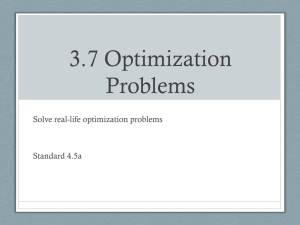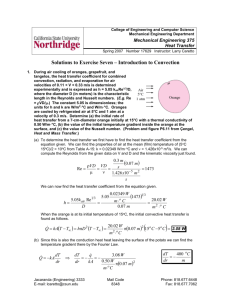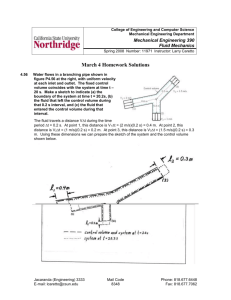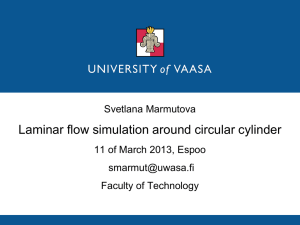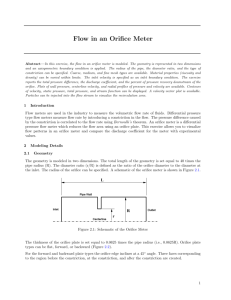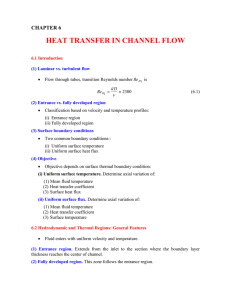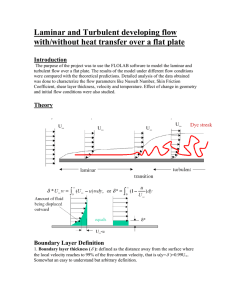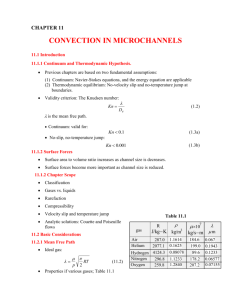Fifth programming exercise
advertisement
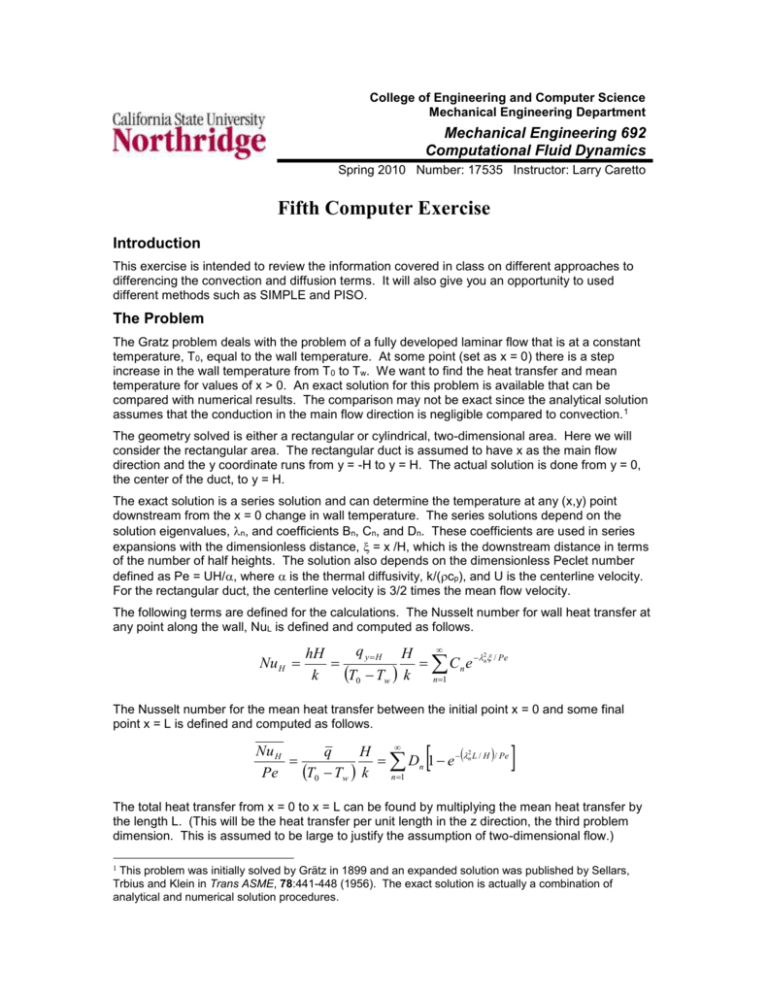
College of Engineering and Computer Science Mechanical Engineering Department Mechanical Engineering 692 Computational Fluid Dynamics Spring 2010 Number: 17535 Instructor: Larry Caretto Fifth Computer Exercise Introduction This exercise is intended to review the information covered in class on different approaches to differencing the convection and diffusion terms. It will also give you an opportunity to used different methods such as SIMPLE and PISO. The Problem The Gratz problem deals with the problem of a fully developed laminar flow that is at a constant temperature, T0, equal to the wall temperature. At some point (set as x = 0) there is a step increase in the wall temperature from T 0 to Tw. We want to find the heat transfer and mean temperature for values of x > 0. An exact solution for this problem is available that can be compared with numerical results. The comparison may not be exact since the analytical solution assumes that the conduction in the main flow direction is negligible compared to convection. 1 The geometry solved is either a rectangular or cylindrical, two-dimensional area. Here we will consider the rectangular area. The rectangular duct is assumed to have x as the main flow direction and the y coordinate runs from y = -H to y = H. The actual solution is done from y = 0, the center of the duct, to y = H. The exact solution is a series solution and can determine the temperature at any (x,y) point downstream from the x = 0 change in wall temperature. The series solutions depend on the solution eigenvalues, n, and coefficients Bn, Cn, and Dn. These coefficients are used in series expansions with the dimensionless distance, = x /H, which is the downstream distance in terms of the number of half heights. The solution also depends on the dimensionless Peclet number defined as Pe = UH/, where is the thermal diffusivity, k/(cp), and U is the centerline velocity. For the rectangular duct, the centerline velocity is 3/2 times the mean flow velocity. The following terms are defined for the calculations. The Nusselt number for wall heat transfer at any point along the wall, NuL is defined and computed as follows. Nu H q yH H 2 hH C n e n / Pe T0 Tw k n1 k The Nusselt number for the mean heat transfer between the initial point x = 0 and some final point x = L is defined and computed as follows. 2 Nu H q H Dn 1 e n L / H / Pe T0 Tw k n1 Pe The total heat transfer from x = 0 to x = L can be found by multiplying the mean heat transfer by the length L. (This will be the heat transfer per unit length in the z direction, the third problem dimension. This is assumed to be large to justify the assumption of two-dimensional flow.) 1 This problem was initially solved by Grätz in 1899 and an expanded solution was published by Sellars, Trbius and Klein in Trans ASME, 78:441-448 (1956). The exact solution is actually a combination of analytical and numerical solution procedures. Fifth computer exercise ME 692, L. S. Caretto, Spring 2010 Page 2 Finally, we can compute the mean temperature at any x location ( = x/H) from the following formulae. ( ) 2 T ( ) Tw Bn e n / Pe T0 Tw n 1 The eigenvalues and coefficients are shown in a table in the appendix and are available on a separate Excel worksheet for computations. The Assignment In the instructions below, items shown in bold represent items that were copied verbatim from the screen. The instruction to “select More Documentation… from the Help menu” means that there is a menu labeled “Help” and you should select the menu item “More Documentation...”. The actions you will take here are similar to those that you took during the first programming exercise. There is a course mesh for this problem on the course web site where you downloaded these instructions. Download that mesh file, pex5Coarse.msh, into the working directory that you are using for Fluent. Start the Fluent code by clicking on the Fluent 6.3.26 icon on your desktop. Select the 2d version. Leave the Mode selection as Full Simulation and click Run. The code continues to load, even after the Fluent screen shows Done; it is fully loaded when you see the command prompt (>). Your first step will be to select ReadCase from the File menu to lead the pex5Coarse.msh into Fluent. You should also check the mesh using the Check command from the Grid menu. Use the DefineModelsViscous command to set the flow to a laminar flow and the DefineModelsEnergy command to check the box to solve the energy equation. Use the DefineMaterials command to set the working fluid to liquid sodium. Enter the following data for this substance: r = 877.8 kg/m 3, cp = 1320 J/kgK, k = 75.84 W/mgK, and m = 3.878x10-4 kg/ms. After you enter the data click the Change/Create button and click No for overwriting the air properties. When you set the initial conditions, select the fluid and set the material to sodium. The flow starts with a uniform velocity at the inlet (zone name flow_inlet) and flows between the wall (zone name: firstwall) and symmetry axis (zone name: symmetryaxisone). This is the initial part of the flow where the wall temperature and fluid temperature are the same. It then passes into a new set of boundaries between zones names wall and symmetryaxistwo. Here is where the wall temperature changes. Set boundary and initial conditions to have an inlet and first-wall temperature of 300 K and the “wall” zone to have a temperature of 500 K. The symmetry axes should have a symmetry boundary condition and the outlet can have an outflow boundary condition. Set a low inlet velocity (about 0.1 m/s) to give a low Reynolds number so the flow will be laminar. You should be able to compare the mean temperature and the wall heat transfer to the second part of the wall between Fluent and the exact solution. Examine the effect of the following input choices on these results: Green-Gauss Cell Based versus Green-Gauss Node based gradient option in the solver; this is equivalent to a choice between first and second order gradient calculations. Discretization options for pressure momentum and energy in the solution controls. Choose among first-order upwind, second-order upwind, QUICK, power-law, and thirdorder MUSCL for momentum and energy. You can also choose the pressure-velocity coupling to be SIMPLE, SIMPLEC, PISO or Coupled. Fifth computer exercise n 1 2 3 4 5 6 7 8 9 10 11 12 13 14 15 16 17 18 19 20 ME 692, L. S. Caretto, Spring 2010 Page 3 Eigenvalues and Coefficients for the Rectangular Grätz Problem Local Nusselt (Bn) Mean temperature Cn Mean Nusselt (Dn) Eigenvalue (n) 1.6815953222391 0.91035216822930000 1.71617334766970 0.6069014454861970000 5.6698573459271 0.05314254972097100 1.13892569950190 0.0354283664806489000 9.6682424629575 0.01527892730289600 0.95213092668037 0.0101859515352641000 13.6676614451110 0.00680881880984830 0.84794745951683 0.0045392125398989300 17.6673735743550 0.00373979862784690 0.77821741160187 0.0024931990852312500 21.6672053492670 0.00232261969991590 0.72693008804375 0.0015484131332772700 25.6670965444640 0.00156409647599700 0.68695101065838 0.0010427309839980200 29.6670211645300 0.00111551116142700 0.65453148735270 0.0007436741076179820 33.6669662941320 0.00083039023391547 0.62747863365344 0.0005535934892769610 37.6669248513710 0.00063900081759387 0.60440839235854 0.0004260005450625820 41.6668926604840 0.00050491280817622 0.58439616358261 0.0003366085387841290 45.6668671202780 0.00040767669082693 0.56679636921005 0.0002717844605512800 49.6668465413330 0.00033513644461742 0.55114208145586 0.0002234242964116130 53.6668297918650 0.00027971958459304 0.53708558742366 0.0001864797230620260 57.6668160973800 0.00023652132406841 0.52436173294045 0.0001576808827122690 61.6668049218740 0.00020225807156217 0.51276396581016 0.0001348387143747790 65.6667958945890 0.00017466855023646 0.50212877380155 0.0001164457001576400 69.6667887633370 0.00015215667857726 0.49232438322555 0.0001014377857181730 73.6667833639300 0.00013357155734950 0.48324363714536 0.0000890477048996646 77.6667795996860 0.00011806720916638 0.47479773029192 0.0000787114727775912

